Head and neck cancer is not common but serious, affecting parts like the mouth and throat. It includes types such as oral and throat cancer. Each year, the UK sees about 12,500 new cases of this cancer.
The illness’s signs are often unclear, causing delays in getting help. This makes the work of general dental practitioners (GDPs) extremely important. They can spot early warning signs, helping patients get the care they need sooner.
There are clear steps for diagnosing and treating head and neck cancers. Every step is based on what the patient prefers and needs. Treatments may involve radiation, chemo, or surgery.
A new hope in treating this cancer is through stem cells which is very promising. It’s making a difference in places like Thailand. More studies are being done to see how this type of therapy can make treatment better and lives improve for people with this cancer.
Key Takeaways:
- Head and neck cancer is a rare disease that affects the upper respiratory and digestive tract.
- General dental practitioners (GDPs) play a crucial role in early detection and referral for head and neck cancers.
- Treatment options for head and neck cancer include radiation therapy, chemotherapy, and surgical intervention.
- Stem cell therapy is an emerging approach that offers potential benefits for head and neck cancer patients.
- Further research and development in stem cell therapy can improve treatment outcomes and enhance patients’ quality of life.
The Role of Cancer Stem Cells in Head and Neck Squamous Cell Carcinoma
Head and neck squamous cell carcinomas are very common, making up over 90% of these cancers. They can start in the lining of the throat, mouth, and other areas of the upper digestive tract. The leading causes of these cancers are smoking, drinking too much alcohol, and HPV infection. Currently, treatments may involve surgery, radiation, or chemo.
Scientists are now looking closely at cancer stem cells (CSCs) in HNSCC’s development. The CSC theory says these cells help tumors grow and resist treatments, leading to more deaths and secondary tumors. Learning about CSCs could help create better, focused therapies for patients with head and neck cancers.
Current Therapeutic Approaches for HNSCCs
| Treatment Modality | Description |
|---|---|
| Surgery | Removal of the tumor and nearby affected tissues. |
| Radiation Therapy | Using high-energy radiation to kill cancer cells. |
| Chemotherapy | Using drugs to kill cancer cells or prevent their growth. |
| Targeted Therapy | Using drugs that specifically target cancer cells. |
| Immunotherapy | Stimulating the immune system to fight against cancer cells. |
| Cancer Stem Cell Targeted Therapy | Targeting cancer stem cells to disrupt tumor growth and improve treatment response. |
Recognizing Symptoms and Seeking Medical Care for Head and Neck Cancers
If someone has head and neck cancer, they might notice certain signs and symptoms. These signs include a sore that won’t heal, patches inside the mouth, or lumps in the neck. They might have a persistently sore throat, bad breath, or a hoarse voice.
You should also watch for signs like trouble breathing, double vision, or weakness in the head and neck. Symptoms like jaw pain, tooth loss, or unexpected weight loss are also concerning. Anyone experiencing these signs should see a doctor right away.
Getting an early diagnosis is key. It can make treatment more effective. This early action could improve chances of getting better.
Supporting cancer patients is important. Providing care during and after treatment can make their lives better. It focuses on easing symptoms and offering comfort.

